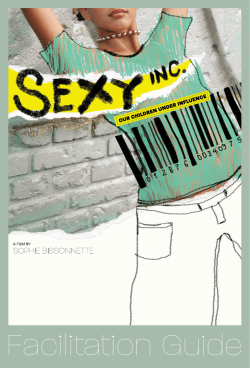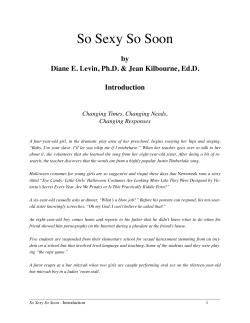
What to say when they ask. Talking about
What when to say they ask. Talking about sexuality with your child What to say when they ask . . . Talking About Sexuality with Your Child 1 4 2 2 Sexuality defined Why parents need to talk about sexuality with their children 3 Children are learning all the time 3 Be an "askable" parent Tips for parents 6 6 8 Introduction What's in a name? It's about attitude 7 Where do babies come from? 7 Two to three year olds 7 Four to five year olds 8 Six to eight year olds Common situations 9 Role playing 10 Masturbation 11 Circumcision 12 Privacy 13 Nudity at home 11 Building self-esteem 14 Some final thoughts 13 Helpful definitions 15 Suggested references 16 Books for parents to read 16 Books for parents to read with their children 1 Introduction Early childhood experiences set the stage for life-long learning. W hat to say when they ask – Talking about sexuality with your child is for parents to help you talk with your son or daughter (up to eight years old) comfortably about sexuality. It will help you answer your child’s questions about sexuality, and will help you understand some situations common to these early years. It’s filled with facts and suggestions to which you can add your own values and beliefs. A Helpful definitions section has been included at the end to define terms and the names of reproductive organs. 2 Sexuality defined Sexuality is an integral part of the total person that affects every facet of his or her life. Sexuality includes all aspects of human sexual development, attitudes, responsibility, personality, emotional characteristics and behaviour. Why parents need to talk about sexuality with their children Nothing can replace the kind of teaching parents can do. As a parent, you can give your child information in a personal way, at times that best meets his or her needs. Sexual health educators suggest that you teach your children a little at a time, answering each question when it’s asked. Honest, straightforward answers in simple language can equip children with correct information and a strong sense of your family’s values. If you can talk to your children about sexuality, you can talk to them about anything. 3 Children are learning all the time Your children learn affection from the way you feed, Children learn about hold and comfort them. You are your children’s primary sexuality every day role model, from the way you express emotion, to your and continue to learn throughout their lives. attitude toward your own body and your children’s bodies. Although much learning takes place without words, it is still important for families to talk about sexuality. A child armed with accurate information and values is more likely to make responsible decisions. Be an “askable” parent Talking about sexuality is more than just talking about Young people get a our bodies. It’s also talking about values, morals, decision making, emotions and feelings. Letting your lot of information child know you are willing to listen and answer his or from sources that are her questions is the most important thing you can do. not factual and don’t • Make the commitment to be the primary sexuality include the values that parents would educator for your children. • Teach them the facts about sexuality and encourage like to pass on to questions. If they only know half the story or have their children. incorrect information, they won’t be able to make responsible decisions. • Talk about the facts, but don’t forget about your values and expectations. Both are important. 4 Tips for parents Use teachable moments to talk to your children about sexuality. These are brief times when your child’s natural curiosity leads to questions about sexuality. Answer the questions briefly and show them you are willing to answer other questions when they come up. • When talking about sexuality, treat it the same way you would any other topic that you discuss. If you are uncomfortable with the subject, practice your answers to a few questions with your partner or a friend. • Discuss your values with your child. Make sure they are consistent with your behavior. By modeling your values in your daily life, messages to your children will be clear and strong. • Point out examples of behaviors that you feel are right or wrong. This is one way to make your values clear. • Make sure that your child understands what types of behaviour are acceptable to you. At the same time, you may point out that other people’s standards may be different from yours. For example, nudity may be a natural occurrence in your home, but your child should understand that other people might behave differently in their homes, and we need to respect their own choice. • Take advantage of situations that might raise questions from your child, such as a friend’s pregnancy, television programs, books you are reading together or newspaper articles. There are many read-to-me books about sexuality for younger children available at public libraries or bookstores. (See Suggested references, page 16). 5 • Always try to answer your child’s questions when they are asked. If you don’t know the answer, say so, but also say you will try to find out and then let them know. • Be prepared to repeat your answers. Don’t assume your child understands your answers the first time they ask. As they grow, so does the need for repeating and expanding on your answers. What's in a name? It’s best to start out using the correct names for all From the time your children begin to talk, they want to know the names of things. parts of the body. For example, use the words penis, breasts, and vulva when your child is having a bath or getting dressed, just as you use the words eyes, ears and nose while teaching your child to wash his or her face. Children should be proud of their bodies and comfortable talking about it using the right names for all body parts. Teaching the correct names for all body parts is also important for safety reasons. Children can better tell us if someone has touched them inappropriately. You teach your children about sexuality both It’s about attitude: non-verbally and verbally. Each time you bathe, dress or you are your child’s toilet train your child, your attitude toward their body most important role model. tells them as much as your answers to their questions about bodies, babies and sexuality. Your actions and expressions, even when changing diapers, lets your children know how you feel about their bodies. If your attitude is positive, your children will learn that bodily functions and parts of their bodies are natural. 6 Where do babies come from? Most children will have questions about where babies come from, pregnancy and childbirth. A parent can answer these questions with simple, straightforward facts. Two to three year olds • Explaining reproduction to children of this age can be as simple as telling them it takes a man and woman to make a baby. • They may ask the same question many times. As their ability to understand grows, more details can be supplied. Four to five year olds • Children in this age group often think babies are made in a hospital. Some four and five year olds think babies grow in the tummy. You should first find out what information they already have and you can then correct any errors before supplying new information. • You could say that the woman’s egg and the man’s sperm join together and grow into a baby in the woman’s body. It’s best not to use the word “tummy” as children associate it with eating. Use the word uterus or womb if the exact location is questioned. • For the child who is curious about how the egg and sperm get together you could say: “Daddy’s sperm are in his testicles and come out through his penis. Mommy’s vagina is the place that leads to where her eggs are. So when Daddy puts his penis in Mommy’s vagina, the sperm will go up and join with Mommy’s egg.” 7 • No matter how clearly this is explained, intercourse and conception are hard for a preschooler to grasp. • Pregnancy is easier for them to understand as they can see the changes in a woman’s body. However, childbirth itself may be confusing. Six to eight year olds • When children of this age group ask how a woman becomes pregnant, you should first find out what they already know. Their answers will give you an idea of how much they know, as well as some idea about why they have asked the question. You can correct any errors before giving new information. • Explain sexual intercourse like you would to a four or five year old. Use the correct words such as “the sperm joins with the egg cell” rather than using expressions such as “plants a seed,” otherwise children may think the baby grows like a plant. • Your children may be getting information from different sources such as television, older children, music, and their friends. All this different information may be confusing so you may need to review the facts with your child. 8 Common situations Role playing Children have a healthy, natural curiosity about their own bodies and those of others. It’s perfectly normal for young children to explore each other’s bodies. It’s your reaction to these role-playing games that is important. • Your actions will depend on your attitudes and the ages of the children. Think about how you feel about this topic before you encounter your child playing with friends – boys and girls – pulling down their underpants and examining each other. Three to four year olds can be easily distracted by another activity. The game they were playing is usually forgotten when the new activity is introduced. • By the time they are five or six, you can let them know you understand their curiosity and urge to explore. However, you can make it understood that bottoms and genitals are private. They should not be exposed casually in front of others. This is another step for children when learning about privacy and sexual manners. 9 • Finding them playing “doctor” is a good example of a teachable moment. For example, you could say, “You seem interested in each other’s bodies. Let’s get a book about bodies and we can read it together.” • Chances are your child may continue to play “doctor” in spite of your teachings. This game will be soon be forgotten as easily as other games played by children at different stages in their young lives. Masturbation Masturbation is a natural way for children to learn about their bodies. • As early as the first few months, children begin to touch their genitals. For babies, this discovery is as fascinating as finding their fingers and toes. • As children grow older, they learn that touching their genitals feels good. • You may feel uncomfortable when you see your child masturbate. Do not overreact. Doing so may leave children with the idea that there is something bad or dirty about their sexual parts. • Children can be taught sexual manners in the same way as they can be taught table manners. Small children can be distracted easily by involving them in some other activity. To an older child you might say, “I know that feels good, but it’s best to do that when you’re alone in your room as it is a private behaviour.” 10 Circumcision Boys want to know why their penis may be different from their father’s or their friends’. It’s important to explain to young boys about circumcision. Usually by the age of four or five, boys notice the difference. You might tell them that some boys have a foreskin that folds over the head of their penis and others have had this skin removed. • When asked the question: “Why is this skin removed?” you can explain the personal or religious reason for your choice. • If your son is not circumcised, the question is good opportunity to talk to about the importance of washing and drying the penis and foreskin when bathing. 11 Privacy What do you do or say to your children if they accidentally see you having sexual intercourse? How you answer this question will depend on their age, how much sexual education they have had and on their temperament. • It’s important to reassure your child that Mommy and Daddy are loving each other. If a child enters your bedroom because they have suddenly awakened, they may not be aware of what Mommy and Daddy are doing. • Older children have probably already been taught to knock before entering. Reinforce this teaching each time they forget to knock. Afterward, explain that parents need time when they can be alone to kiss and hold each other. • It’s important to establish rules of privacy for both adults and children to follow. That way, children will learn to knock before entering a place where someone has gone to be alone. They will also learn that they have their own right to privacy that should be respected. 12 Nudity at home Casual nudity refers to the natural times when a child may see you when getting dressed, showering, or sleeping without clothes. Being natural about nudity will help your children develop a positive attitude about their bodies. • If parents are very secretive about their bodies, a child can become more curious to know what is being hidden from their view. • If you are comfortable with nudity, your children will probably adopt your attitudes. • Children will go through times when they are very modest about their bodies and will avoid having anyone see them naked. This is a normal stage in their growth and development, and should be respected. • Whether or not your children see you nude, they may be exposed to others’ nudity, for example, in the changing rooms at the swimming pool, on television, or in books and magazines. It’s important to tell your children that everyone’s views on nudity are not the same. This will help them respect the views and behaviors of others when they are away from home. 13 Building self-esteem One of the most important things you can do for your children is to help them gain self-respect and pride in Helping your children feel good about themselves is important at any age. It is even more important for our children heading into puberty, because they will soon experience many emotional and physical changes. Here are some things you can do to help your children feel good about themselves: • Let them know you appreciate them. Recognize their talents, personality, skills and accomplishments. themselves. Avoid comparing them with others. • Treat them with respect. Ask for their opinions and listen to their ideas and feelings. Their self-respect begins with the respect and consideration they receive from you and others. • Let them know that while you may not like behaviour they demonstrate sometimes, that doesn’t change your love for them. Meanwhile, look for the feelings causing your child’s behaviour. • Don’t expect too much or too little. It is important to let them know that you have confidence in them. You can support them without pushing and protect them without keeping them from new experiences. Some final thoughts We know talking about sexuality with your children is not an easy task. This brochure is intended to help you start an ongoing discussion with your children about sexuality. It’s a start but covers only a small part of all there is to know. See Suggested references (page 16) for more information available at libraries or bookstores. Your local community health care centre is also a good source of information. 14 Helpful definitions circumcision: surgical removal of the foreskin from the male’s penis. conception: the joining of the female egg and male sperm to start a pregnancy. estrogen: the female sex hormone, made by the ovaries, which causes body changes in girls during adolescence. genitals: sexual organs (internal and external). hymen: a ring of tissue, which may partly cover the opening into a female’s vagina. labia: the “lips” or folds of flesh in the female vulva, which surround the opening of the vagina. masturbation: stimulation of one’s genitals. menstruation: shedding of the uterine lining of the female, which has formed in preparation for a fertilized egg. non-verbally: not expressed in spoken words; expressed in other way such as gestures, facial expressions and body posture. ovary: the female organ that produces estrogen and egg cells (ova). ovulation: the release of a mature egg from a female’s ovary. penis: the tube-like external sex organ of males. puberty: the period of change and development when boys and girls start to physically mature. semen: a mixture that is made up of sperm and fluid from the seminal vesicles and the prostate gland, and released from the male’s penis. sexual intercourse: insertion of the penis into the vagina. sexuality: an integral part of the total person that affects every facet of his or her life. Sexuality includes all aspects of human sexual development, attitudes, responsibility, personality, emotional characteristics and behaviour. sperm: a male reproductive cell produced in the testicles. testicles (testes): male sex glands that make testosterone and male sperm. testosterone: male sex hormone that is made by the testicles, which causes body changes in boys during adolescence. urethra: the tube through which urine leaves the body in both sexes and through which semen moves in males. uterus: pear-shaped muscular organ located in the female’s pelvic region that holds and nourishes a baby until birth. vagina: the passageway of muscle and tissue that connects a female’s uterus to outside of the body; the birth canal and organ for sexual intercourse. vulva: external female sex organs. 15 Suggested references Books for parents to read All About Sex: A Family Resource on Sex and Sexuality Planned Parenthood Three Rivers Press, New York, 1997 What’s the Big Secret? Talking about Sex with Girls and Boys Laurie Krasny Brown, Ed.D and Marc Brown Little, Brown & Company (Canada) Limited, 1997 Speaking of Sex: Are You Ready to Answer the Questions Your Kids Will Ask? Meg Hickling Northstone, 1996 The Family Book About Sexuality Mary S. Calderone and Eric W. Johnson Harper and Row, Revised 1989 Books for parents to read with their children For children under six Did the Sun Shine Before You Were Born? Sol Gordon and Judith Gordon Ed-U-Press, 1988 Bellybuttons are Navels Mark Schoen Video and Parents/Teachers Guide Focus International, 1990 What is a Girl? What is a Boy? Stephanie Waxman Woman’s Press, 1989 For children six to ten Everybody has a Bellybutton: Your Life Before You Were Born Lawrence Pringle Boyds Mills Press, 1997 Changes in You and Me P. Bourgeois and M. Wolfish Somerville, 1994 Girls are Girls and Boys are Boys - So What’s the Difference? Sol Gordon Ed-U-Press, 1985 It’s Perfectly Normal Robie Harris Candlewick, 1994 For Adolescents What’s Happening to My Body (for boys) What’s Happening to My Body (for girls) Lynda Madaras Newmarket Press, 1987 Period J. Gardner-Loulan,, B. Lopez, and M. Quackenbush Volcano Press Ltd., 1991 16 Alberta Health and Wellness web site: www.health.gov.ab.ca June 1999
© Copyright 2025





















